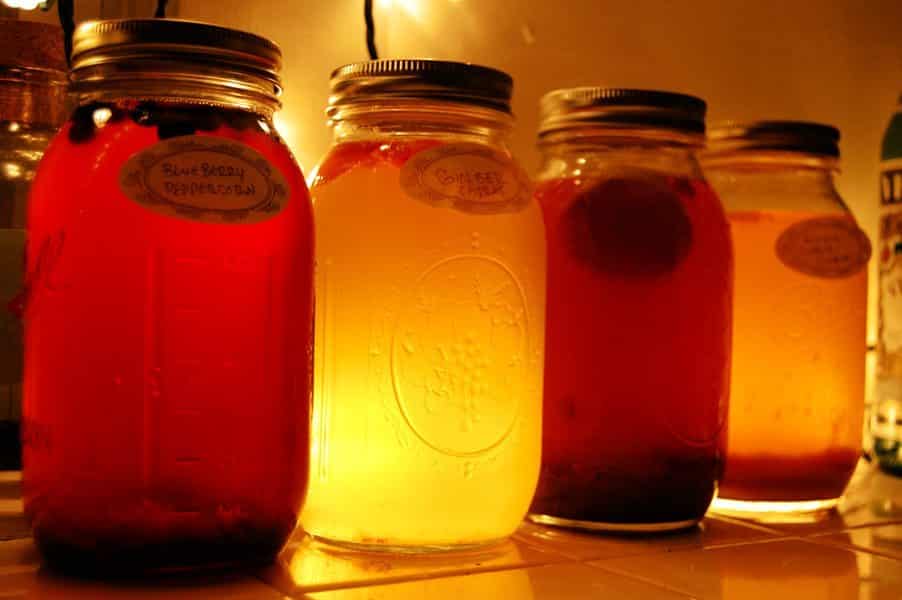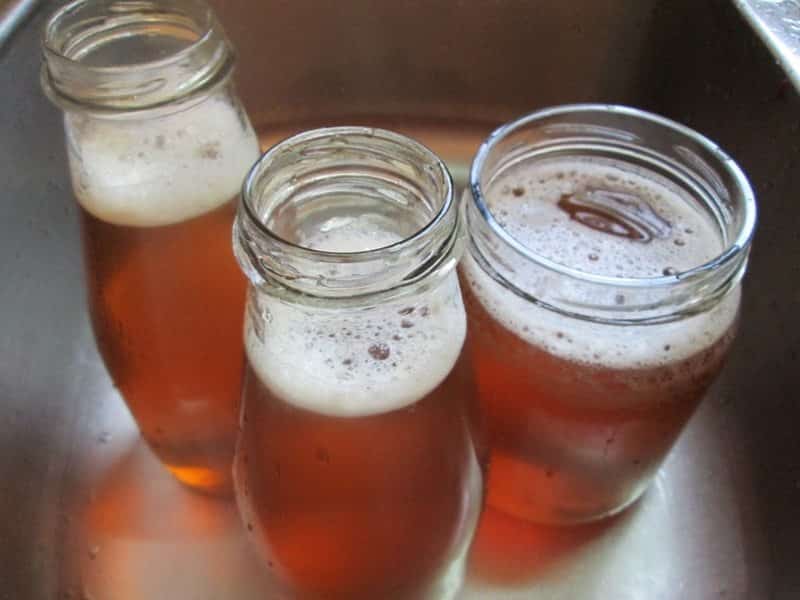How To Estimate The Perfect Kombucha Brew Time

You want a brewed kombucha tea that has just enough sweetness to balance out the organic acids produced by the SCOBY (the Symbiotic Colony Of Bacteria and Yeast) but you don’t want it to be too sweet. Unless you’re going to be doing a second fermentation, in which case you need to leave some sugar in the brew – but not too much. And of course you want to make sure that the balance of the microorganisms in your SCOBY doesn’t get out of whack, while still maintaining the right pH levels. Finally, you want to make sure that you’ve got everything ready to bottle and store the kombucha when it’s done.
Regulating the brewing time of kombucha means controlling the action of the yeasts and bacteria in the brew, as well as the levels of sugars they have to work with and the amount of ethanol, CO2, and acids they produce. This is an evolving process that depends on the ingredients you use, the health of your SCOBY, the temperature of the brewing environment, and the flavor you’re looking for.
pH and Flavor
These two things are linked, but are not identical. The pH of the kombucha refers to its acidity, and the flavor refers to what you think about that acid taste. Some people like a very acid kombucha, while others prefer a sweeter drink. When you first start a batch of kombucha tea, you’ll have a liquid that is more sweet than sour. As the SCOBY microorganisms work, they will convert the sugars to organic acids.
Once the pH of the kombucha is at or below 4 it is safe to drink. You can test the pH level using an electronic pH meter or disposable pH test strips . In general, brewed kombucha should have a pH of between 2.5 and 3.5 for the best long-term storage.
As well as testing the pH, you should taste your kombucha every day while it’s brewing. This will let you monitor the changes in flavor and acidity.
Second Fermentation and Storage
When you bottle and continue to ferment your kombucha, the residual yeasts and bacteria continue to work, even in the anaerobic (without oxygen) environment of the closed containers. Depending on the results you want, you’ll need to remove the SCOBY from the brewing container at different times.
Bubbles. If you want to increase the carbonation in kombucha tea with or without any added flavors, you’ll need to leave enough sugar in the brewed kombucha to provide the yeasts with the food they need to create the CO2 after you’ve bottled the tea. That means you’ll remove the SCOBY while the tea is still slightly sweet.
Flavors. The longer the fermentation continues, the more developed and complex the flavors are. You can stretch out the primary brewing period by carefully adjusting the temperature and monitoring the pH levels, and this will help you create more depth of flavor. You can also extend the brewing period after bottling. When the flavor is exactly the way you like it, remove the SCOBY, bottle the brew, and refrigerate it. This will slow down the microbial action so that the acid balance stays the same.
How the SCOBY Affects Brew Time
The age, health, and size of your SCOBY will all affect how quickly your kombucha tea ferments.
Keep in mind that you DON’t actually need a SCOBY in your kombucha brew to make kombucha. The most important thing is the Kombucha starter (1-2 cups of kombucha from a previous batch), which contains the same yeasts and bacteria that’s found in the SCOBY, but just not bunched into visible colonies.
If you do not have a SCOBY but put in Kombucha starter, it will just take a lot longer to ferment your kombucha — 3-5 times longer than with a SCOBY. But it will still happen. The time will of course depend on how active the bacteria and yeast cultures are, the temperature in the room, how much sugar you have, the type of tea and how much Kombucha starter liquid. I have had cases where I’ve done a second ferment (taken SCOBY out) and added fruit and in 3 days, a new SCOBY actually formed at the top of the second ferment brew. So there is no hard and fast rule how long a new SCOBY will form in your brew when you don’t have one in it.
Here’s some noteable points about how SCOBY affects the brew time:
- Newer SCOBYs will usually have more active yeast and bacteria, but very thin SCOBYs won’t have enough microorganisms to efficiently ferment the kombucha tea. Most expert brewers recommend keeping a baby SCOBY with its mother until the baby is at least 1/4 inch thick before removing the baby SCOBY from the mother.
- Older SCOBYs may have more inactive microorganisms, especially in the older layers on the bottom of the colony. They may also have strands of yeast that build up on the bottom and lower edges. To remove extra yeast and inactive microorganisms, divide your SCOBY regularly to peel away the older layers.
- A SCOBY that is very thick may block the oxygen flow to the lower layers of the colony and to the free-swimming microorganisms in the liquid. This will slow down the fermentation process.
- If you are growing a SCOBY from scratch, you will need to wait for the SCOBY to reach at least 1/4 to 1/2 inch thick before you can use it for reliable, efficient fermentation of your kombucha tea. Having no SCOBY in your brew means it will take 3-5 times longer to brew your buch (and to form a new SCOBY).
- If you think that your SCOBY is too old or otherwise unhealthy because fermentation seems to be taking longer than usual, it’s a good idea to throw away that SCOBY and start over with a younger one.
How Temperature Affects Brew Time

To put it simply, a higher temperature leads to quicker fermentation, and a lower temperature creates slower fermentation. However, it’s not always that simple.
When the temperature of the liquid in the brewing container is too high, the yeasts will grow and reproduce more quickly than the bacteria. This will change the flavor of the kombucha, and will make it slightly more alcoholic, because the bacteria won’t be able to process the ethanol quickly enough. Too much heat and the bacteria will actually die, which means your pH levels will not remain low enough for you to safely drink the kombucha.
If the temperature is too low, on the other hand, the fermentation may go too slowly to lower the pH in time to prevent toxic bacteria and molds from invading and colonizing the kombucha tea.
The Ideal Temperature
If you are using a standard kombucha recipe and you can keep the temperature of the liquid in the brewing container at a constant level of 75F (plus or minus a degree or two) then you can expect your kombucha to be properly fermented with a good balance of flavors, sweetness, and acidity in 10 days on average. However, each brewing environment and each SCOBY is different. If you can keep to this 75F temperature and test your kombucha to see exactly when it is completely fermented with the flavor you want, make a note of how long it takes. You’ll be able to use that to judge how long other brews will take when you change any element of the brewing cycle, whether that’s the temperature, the SCOBY, or the ingredients.
Why You Might Change Temperature
Many of the organic acids that contribute to the health benefits of kombucha generally do not fully develop until the kombucha tea has been fermenting for at least two weeks under normal circumstances. By lowering the temperature of the brewing container, you can slow down the fermentation process – which is primarily done by the yeasts – to give the bacteria in the SCOBY more time to produce these organic acids.
You can speed up the fermentation process by using a slightly higher temperature, so long as it’s not too high. Temperatures over 85F will cause the yeast to develop faster than the bacteria, leading to a SCOBY and brew that’s out of balance. However, raising the temperature to around 80F can reduce the brewing time without creating problems for the colony. If you’re having problems keeping your kombucha cool in hot weather there are ways to regulate the temperature of the brewing container to avoid these problems.
How Ingredients Affect Brew Time
The sugar you use, the tea you brew, and even the water you choose will affect how long your kombucha will take to ferment.
- Sugar that’s easy for the SCOBY to break down will feed it more quickly than complex, mineral-rich sugars. If you use organic raw cane sugar, fermentation will go quickly. If you use unrefined palm sugar or molasses, the process will go more slowly.
- Too much sugar can actually hurt the SCOBY, so don’t be tempted to add extra sugar just to speed things up. A little extra can help boost the action of the yeasts and bacteria, especially with second ferment kombucha but sugar-saturated liquid will kill off the microorganisms.
- Weak tea, or tea that is a mixture of herb tea and regular tea, will not provide the SCOBY with all of the nutrients it needs. Test your SCOBY for several batches by using the standard amount of tea, brewed to the right strength, before you experiment with different tea components.
- Hard water, soft water, mineral-rich water, and chlorinated tap water will all affect the SCOBY and its microorganisms. Never use chlorinated tap water without filtering it first, because the chlorine will kill off the bacteria in the SCOBY.
How Surface Area Affects Brew Time
The microorganisms in the SCOBY need oxygen to grow and reproduce. You’re covering the brewing container with a tightly-woven cloth to let the oxygen in and the CO2 out, but you need to also consider the size of your brewing container when thinking about airflow.
A container with a narrow opening may not let enough oxygen in to support the SCOBY, and this will slow down the fermentation process. Use wide-mouthed jars or even a deep bowl to ferment your kombucha tea, rather than trying to ferment the tea directly in bottles or other tall narrow containers.
On the other hand, having too much surface area isn’t good, either. It will speed up the oxygen flow, but it will also stress your SCOBY because the SCOBY will start spreading out to cover the entire surface of the liquid. Some of that liquid will evaporate, and the SCOBY will be stretched out, making it thinner and more prone to contamination.





